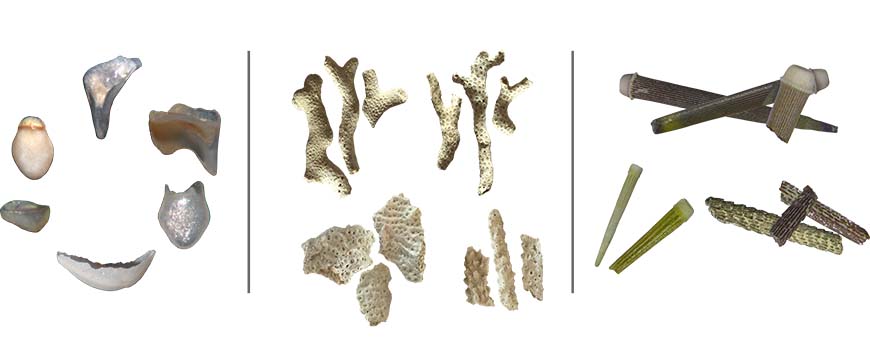Global S&T Development Trend Analysis Platform of Resources and Environment
| Study Finds Parrotfish are Critical to Coral Reef Health | |
| admin | |
| 2017-01-23 | |
| 发布年 | 2017 |
| 语种 | 英语 |
| 国家 | 美国 |
| 领域 | 资源环境 |
| 正文(英文) |  Parrotfsh, coral, and urchin fossils An analysis of fossilized parrotfish teeth and sea urchin spines by researchers at Scripps Institution of Oceanography at the University of California San Diego showed that when there are more algae-eating fish on a reef, it grows faster. In the new study, published in the Jan. 23 issue of the journal Nature Communications, Scripps researchers Katie Cramer and Richard Norris developed a 3,000-year record of the abundance of parrotfish and urchins on reefs from the Caribbean side of Panama to help unravel the cause of the alarming modern-day shift from coral- to algae-dominated reefs occurring across the Caribbean. “Our reconstruction of past and present reefs from fossils demonstrates that when overfishing wipes out parrotfish, reef health declines,” said Cramer, a postdoctoral researcher at Scripps and lead author of the study. Algae-eating parrotfish, like other herbivorous reef fish, play an important role in coral reef ecosystems by removing the algae that compete with corals. According to the study, the decline in herbivorous fish such as parrotfish over the last several decades from fishing is considered a main factor in the shift to more algae-dominated reefs in the Caribbean. The Scripps researchers examined the amount and composition of fish, coral, and urchin fossils in 3 to 5-meter (10 to 33-feet) long sediment cores from three reef sites offshore of Bocas del Toro, Panama to understand the natural state of the reefs before humans began intensive fishing and land clearing, and to assess the role of these activities in recent reef declines. The analysis was aimed at determining if coral growth rates are affected by change in the population levels of parrotfish or urchins that eat algae. The core samples, extracted by the researchers using a portable coring system they operated underwater while scuba diving, included fossils ranging from those deposited during prehistoric times, as early as 997 BC, to those from the modern post-industrial age up to the 1980s, representing life on these reefs during a period of rapidly increasing human impacts to reef ecosystems. Cramer and Norris then used the empirical dynamic modeling approach developed by Scripps ecologist George Sugihara and colleagues to assess cause-and-effect relationships in ecological systems. They found that coral growth is positively driven by the abundance of parrotfish on the reefs but not affected by sea urchin abundance. “These findings reveal that parrotfish indeed have a positive and critical role in coral health, a hotly debated issue in coral reef research that cannot be resolved with studies of modern reefs which have already been greatly altered by human activities,” said Cramer. “Using the fossil record to analyze the natural state of reefs before human disturbance, we have conclusively shown that if we want to protect corals we have to protect the parrotfish from overfishing.” “These results confirm the critical role of parrotfish in maintaining coral-dominated reef habitat and the urgent need for restoration of parrotfish populations to enable reef persistence,” said the authors. Cramer was supported by the Smithsonian Institution’s Marine Global Earth Observatory (MarineGEO) and UC San Diego Frontiers of Innovation Scholars Postdoctoral Fellowships.
Note to broadcast and cable producers: University of California San Diego provides an on-campus satellite uplink facility for live or pre-recorded television interviews. Please phone or email the media contact listed above to arrange an interview.
About Scripps OceanographyScripps Institution of Oceanography at the University of California San Diego, is one of the oldest, largest, and most important centers for global science research and education in the world. Now in its second century of discovery, the scientific scope of the institution has grown to include biological, physical, chemical, geological, geophysical, and atmospheric studies of the earth as a system. Hundreds of research programs covering a wide range of scientific areas are under way today on every continent and in every ocean. The institution has a staff of more than 1,400 and annual expenditures of approximately $195 million from federal, state, and private sources. Scripps operates oceanographic research vessels recognized worldwide for their outstanding capabilities. Equipped with innovative instruments for ocean exploration, these ships constitute mobile laboratories and observatories that serve students and researchers from institutions throughout the world. Birch Aquarium at Scripps serves as the interpretive center of the institution and showcases Scripps research and a diverse array of marine life through exhibits and programming for more than 430,000 visitors each year. Learn more at scripps.ucsd.edu and follow us at Facebook, Twitter, and Instagram.About UC San DiegoAt the University of California San Diego, we constantly push boundaries and challenge expectations. Established in 1960, UC San Diego has been shaped by exceptional scholars who aren’t afraid to take risks and redefine conventional wisdom. Today, as one of the top 15 research universities in the world, we are driving innovation and change to advance society, propel economic growth, and make our world a better place. Learn more at www.ucsd.edu.
|
| URL | 查看原文 |
| 来源平台 | Scripps Institution of Oceanography |
| 文献类型 | 新闻 |
| 条目标识符 | http://119.78.100.173/C666/handle/2XK7JSWQ/107653 |
| 专题 | 资源环境科学 |
| 推荐引用方式 GB/T 7714 | admin. Study Finds Parrotfish are Critical to Coral Reef Health. 2017. |
| 条目包含的文件 | 条目无相关文件。 | |||||
| 个性服务 |
| 推荐该条目 |
| 保存到收藏夹 |
| 查看访问统计 |
| 导出为Endnote文件 |
| 谷歌学术 |
| 谷歌学术中相似的文章 |
| [admin]的文章 |
| 百度学术 |
| 百度学术中相似的文章 |
| [admin]的文章 |
| 必应学术 |
| 必应学术中相似的文章 |
| [admin]的文章 |
| 相关权益政策 |
| 暂无数据 |
| 收藏/分享 |
除非特别说明,本系统中所有内容都受版权保护,并保留所有权利。
修改评论